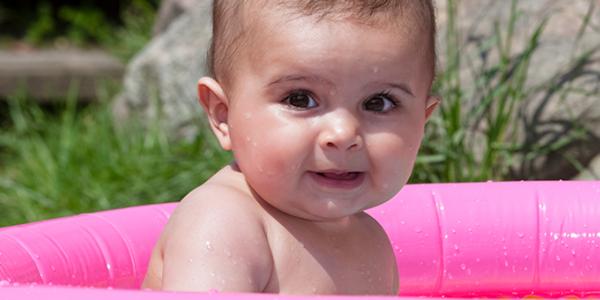By: Sarah Erdman
There is a reason that the story of Archimedes shouting “Eureka” in the bathtub persists. Baths are a great time for thinking and an excellent place for scientific investigation. At our house, my 1-year-old son’s baths are one of his favorite times to explore and one of my favorite times to support his learning. There is so much to explore and learn with very little equipment, and clean up couldn’t be easier!
These same explorations could happen in a pool, bucket, or any body of water with very little adjustment. This gives the opportunity for children to explore together. Just make sure to keep safety in the forefront. NEVER leave a child alone during water play…even for a minute. I can’t stress that enough. Make sure that any toys or containers dry out completely between uses, and sanitize toys if multiple children will use them. Be sure to monitor toys for mold and replace them when needed. More complete water safety tips can be found through the Red Cross.
When I think about it, during the course of my son’s bath last night we touched on physics, marine biology, anatomy and acoustics, and he was squeaky clean by the end of it!
Here are some ways we use bath time to explore science together
One of my son’s favorite toys is a set of cups with little holes in the bottom. This is a toy that could easily be made by poking some holes in a plastic cup, or by purchasing a set of small colanders. He has found multiple ways to use them and each way gives him a little more insight into how the world works. He nests them together and pulls them apart. I hold a cup up high while the water trickles out and he tracks the flow back to where the water is coming from, and then tips it over to see what happens. He puts the cups on his feet and tries to balance them on his head and hunts for them when they float away.
One time, my husband put the cups over my son’s ears. He sat for a minute, listening to the different sounds, then giggled and pull the cups off his ears. Within a minute though, he was tugging at my husband’s hands to get him to do it again. Perhaps he was experiencing and exploring how our voices and the sound of splashing water was muted. There’s so much to explore, experience, and learn.
Bath time can also be a place to learn new words and sounds and have conversations. Joining him in the bath is a rubber ducky. When my son grabs the duck to play, our conversation changes to involve a lot of quacking! I might also talk to him about where ducks live or quote from books about ducks we’ve read together
When we have to get down to the business of getting clean, I name each part of the body that is getting soaped up. He isn’t quite at the point where he can find his own nose…but we will get there. During the day I sometimes struggle to keep up a flow of conversation, even though I know that describing his world positively impacts his language skills. Using vocabulary during bath time is so much easier for me because it is straightforward and specific.
Then, there is the splashing. My silly boy didn’t start splashing until recently and now he can’t stop! I can tell he is investigating what happens when he splashes softly versus with great vigor. And he loves to explore what happens when he splashes water in my direction! Of course all the splashing and the giggles also make great echoes, for an added bonus of sounds to explore.
Bath time highlights what I think is one of the best thing about science with babies and toddlers, and that is just how seamlessly exploring science concepts can fit into your day. You don’t have to learn new techniques or buy fancy toys, just keep doing what you do, spending time together, talking and exploring, and stay thoughtful about how you do it.
Sarah Erdman is an experienced early childhood educator and museum professional in Northern Virginia. She teaches at FB Meekins Cooperative Preschool. [email protected]

